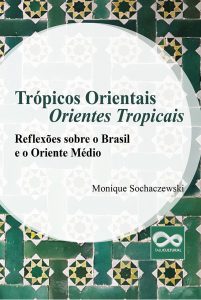São Paulo – The orientalism of Dom Pedro II, Middle Eastern influences in Rio de Janeiro, Syrian refugees in Turkey, and modern-day geopolitics in Morocco. These are some of the subjects covered in the essays featured in Trópicos Orientais, Orientes Tropicais – Reflexões sobre o Brasil e o Oriente Médio (Oriental Tropics, Tropical Orients – Reflections on Brazil and the Middle East), a book by Monique Sochaczewski (pictured), who holds a doctorate in History from FGV-Rio and is the academic coordinator for the Brazilian Center for International Relations (Cebri), in Rio de Janeiro. The book will be released 5 pm on May 30 at the Cebri headquarters in the Gávea neighborhood.
The launch event will include a signing session and a discussion panel. Besides the author, panelists will include PUC-Rio International Relations Institute professor and Cebri senior fellow Monica Herz; and ambassador Gelson Fonseca, an adviser at Cebri and the director of the Brazilian Ministry of Foreign Affair’s Center for History and Diplomatic Documentation (CHDD).
Sochaczewski told ANBA that the book is a collection of columns written for online magazine Diáspora, which covers Middle East and North Africa affairs in connection with Brazil.

The first – and longest – essay in the book is O Orientalismo Peculiar de Dom Pedro II (Dom Pedro II’s Peculiar Orientalism), which addresses the former emperor of Brazil’s passion for the Middle East and North Africa. “Dom Pedro II visited Egypt on two different occasions and spent four months touring the region. He also traveled to what are now Lebanon, Syria and Palestine, as well as other portions of the then-Ottoman territory. He was truly interested in acquiring knowledge on the region,” said Sochaczewski, who specializes in the Ottoman Empire.
Rio Médio-Oriental (Oriental-Middle Rio) covers Arab and Oriental influences in Rio de Janeiro areas like Cinelândia and Saara, an Eastern/Arab stronghold in downtown Rio since the early 20th century. Sochaczewski organizes walking tours of these neighborhoods in which she points out the oriental features in the architecture and cuisine. “We begin with Cinelândia. Though once known as the ‘Paris of the Tropics’ due to its French-influenced architecture, it features lots of details from the Arab world; after that we move on to the Saara, with its Arab awnings; the centennial bakery Padaria Bassil, which carries the best sfiha and Arab bread in town; and finally Seu Joel’s traditional Syrian-Lebanese restaurant,” Sochaczewski said. This essay mentions an ANBA report about a tour of downtown São Paulo offered by SESC Santo André last February, which included sites like Pátio do Colégio and 25th of March Street. The tour traced back the history of Arab immigration to the city, predominantly from Syria and Lebanon.
Other essays cover Brazilian academic and audiovisual production about the region; modern-day Morocco geopolitics; the issue of Syrian refugees in Turkey; and Kurdish women, among other topics.
“This book has no major aspirations. It was born of an invitation to share knowledge. The texts are short and accessible to anyone with an interest in the East,” said Sochaczewski. She made a point of saying it was she who took the cover photo in Marrakech, Morocco. “It’s a green and yellow tile. I found it to be symbolic, because it’s a real typical Arab mosaic, but it has the colors of Brazil,” she concluded.
Quick facts
Book launch – Trópicos Orientais, Orientes Tropicais – Reflexões sobre o Brasil e o Oriente Médio
Monique Sochaczewski
Signing session and discussion panel
May 30, Thursday, 5 pm
Rua Marquês de São Vicente, 336 – Gávea
Rio de Janeiro
Free of charge
Translated by Gabriel Pomerancblum




